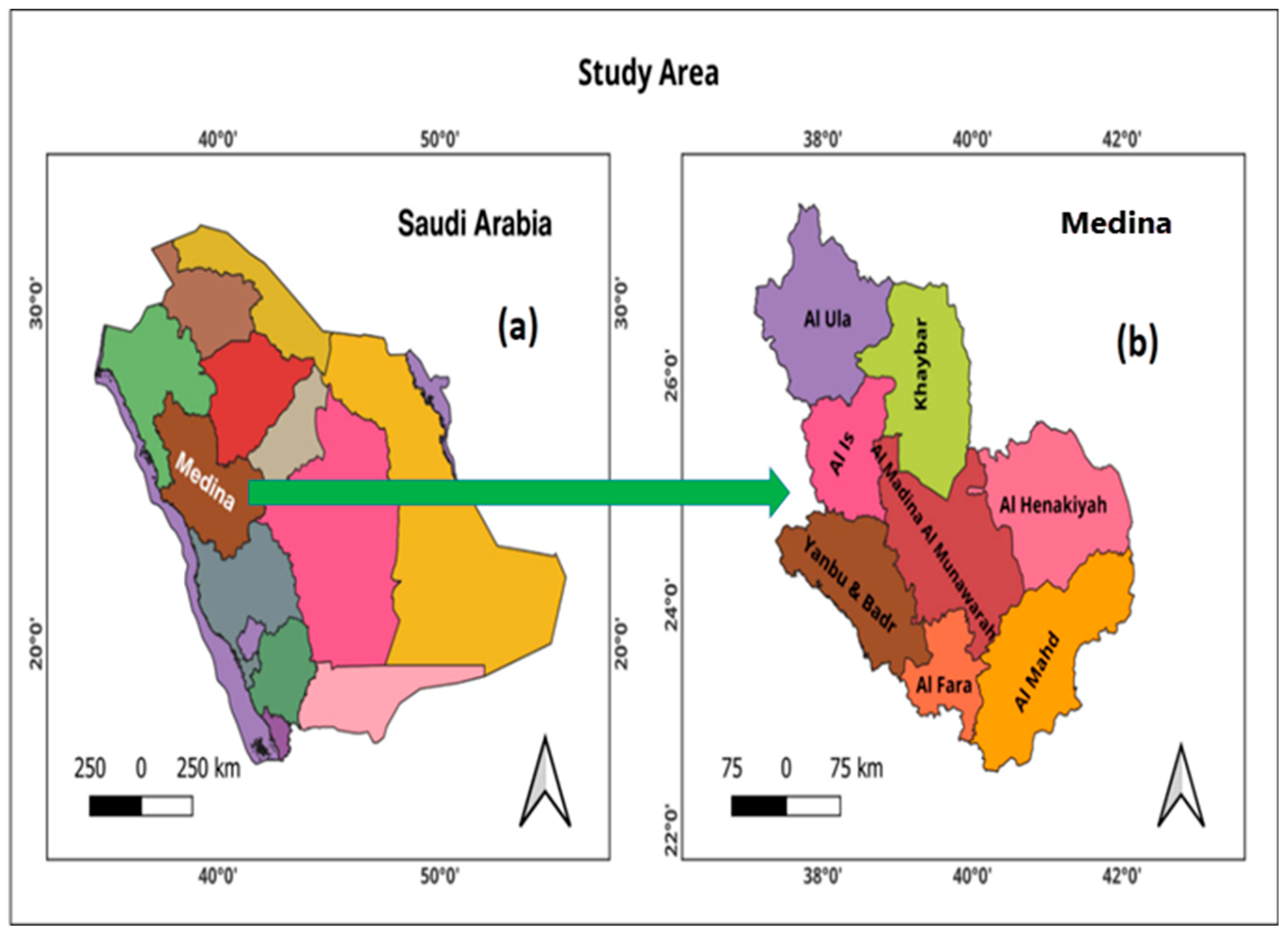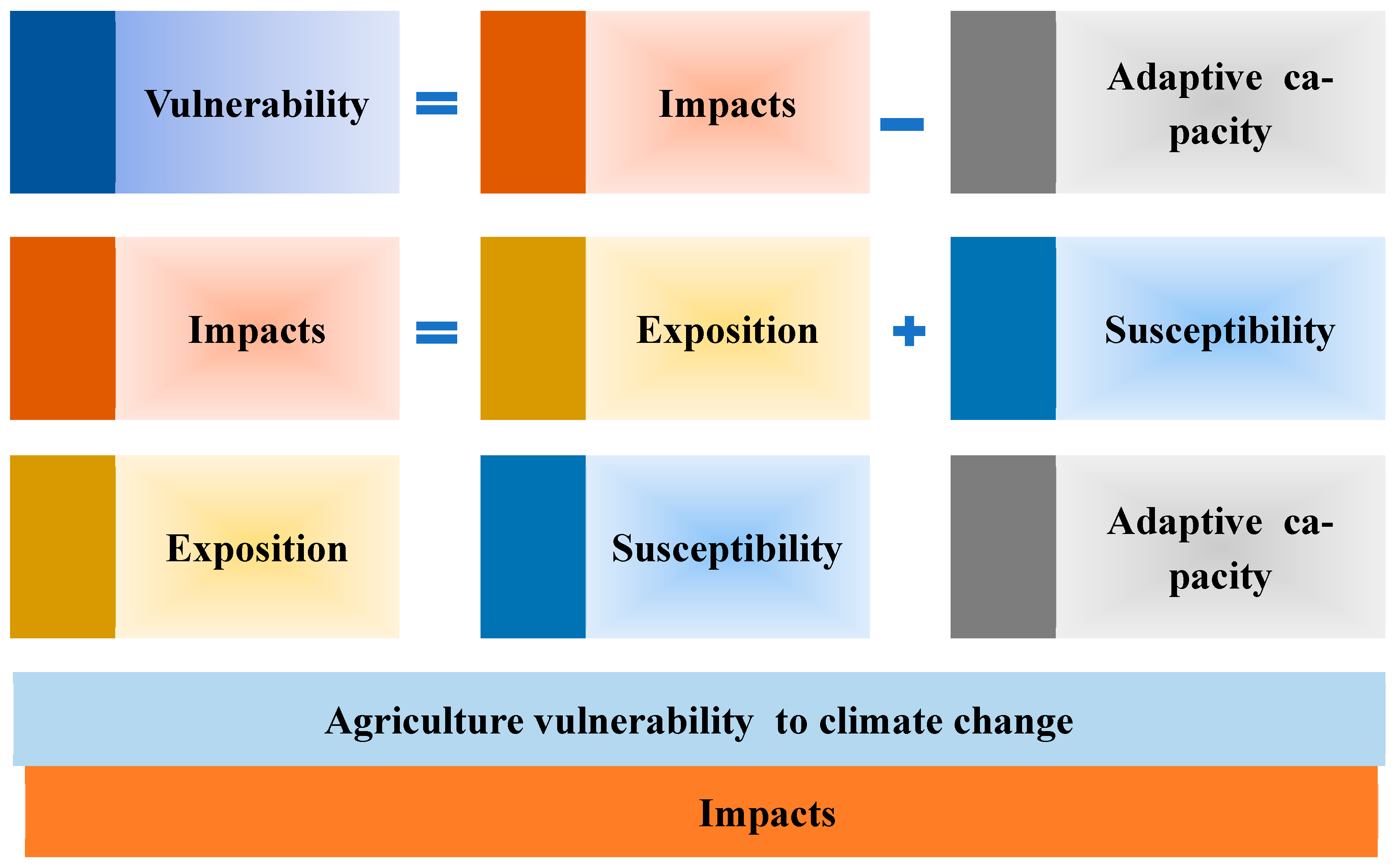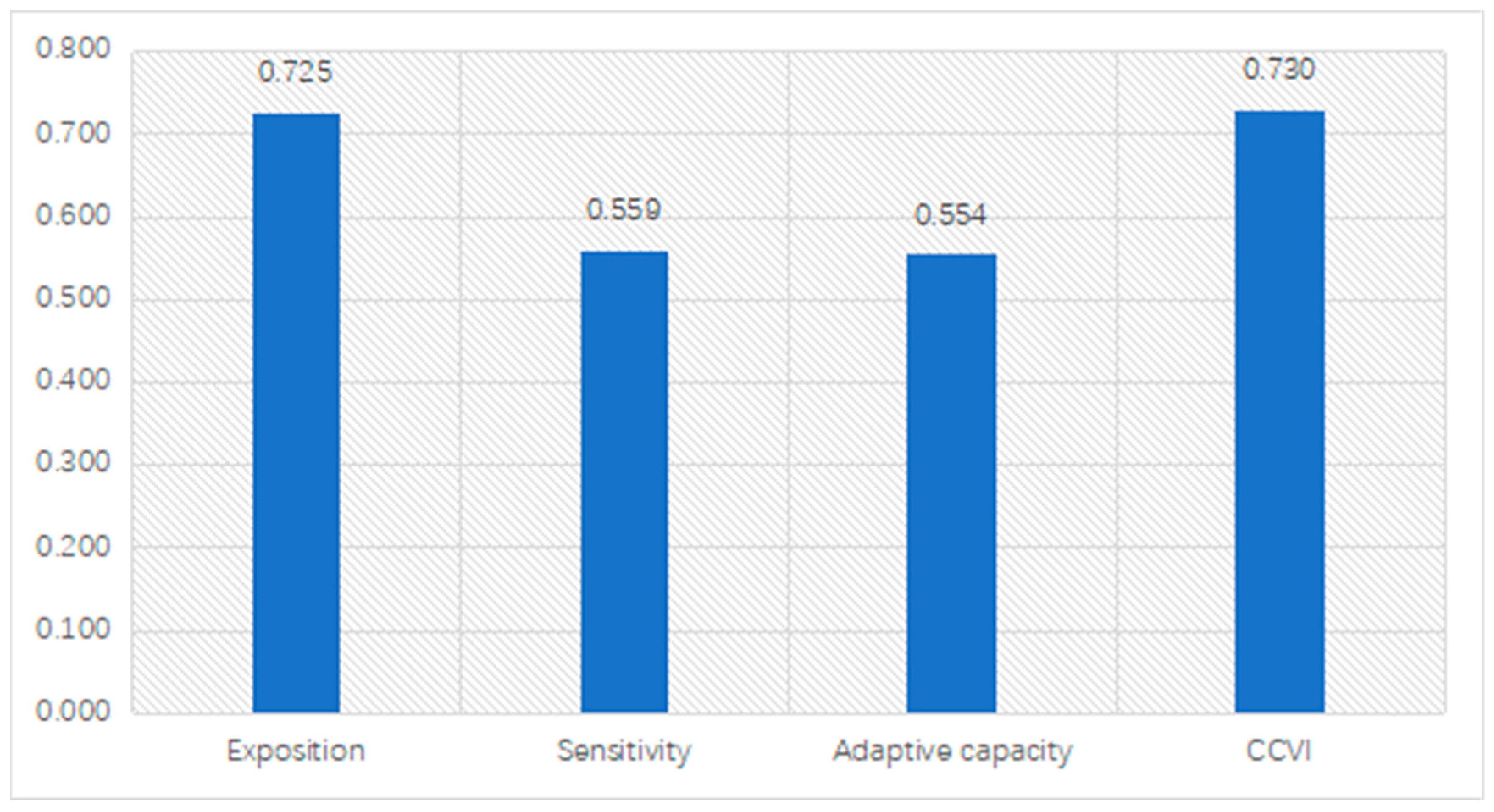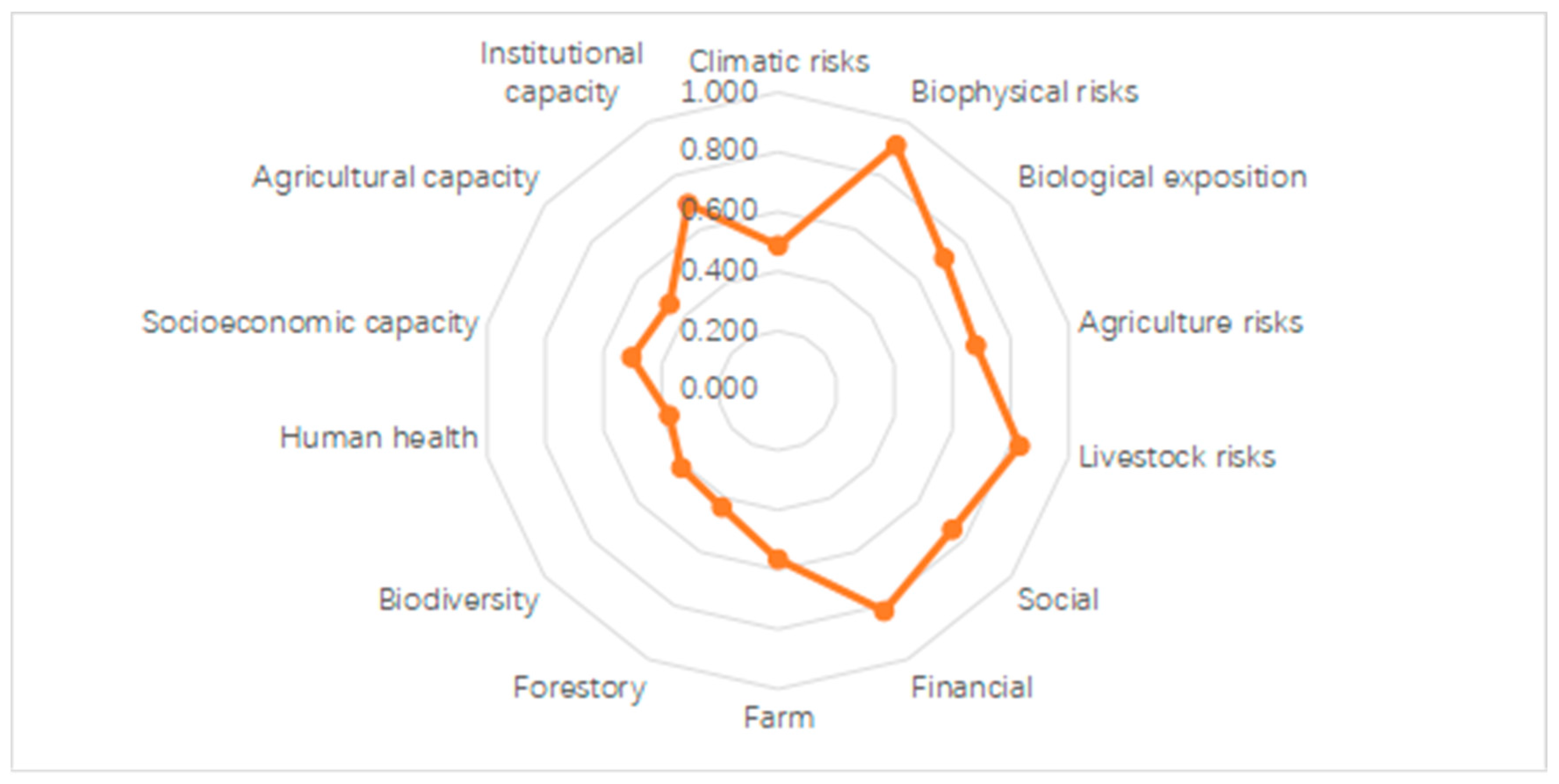Exploring Climate-Induced Agricultural Risk in Saudi Arabia: Evidence from Farming Communities of Medina Region
Abstract
1. Introduction
2. Materials and Methods
2.1. Study Area Description
2.2. Research Design
2.3. Survey Instrument
2.4. Analytical Framework
2.4.1. Vulnerability Assessment and Component Selection
2.4.2. Index Calculation
3. Results and Discussion
3.1. Exposition
3.2. Sensitivity
3.3. Adaptive Capacity
3.4. Overall Farms Households’ Climate Change Vulnerability Index (CCVI)
4. Conclusions and Policy Implications
Author Contributions
Funding
Institutional Review Board Statement
Informed Consent Statement
Data Availability Statement
Declaration of Generative AI and AI-Assisted Technologies in the Writing Process
Acknowledgments
Conflicts of Interest
References
- Bator, A.; Borek, A. Adaptation to Climate Change under Climate Change Treaties. Int. Community Law. Rev. 2021, 23, 158–167. [Google Scholar] [CrossRef]
- Stern, N. A Time for Action on Climate Change and a Time for Change in Economics. Econ. J. 2022, 132, 1259–1289. [Google Scholar] [CrossRef]
- Malhi, G.S.; Kaur, M.; Kaushik, P. Impact of Climate Change on Agriculture and Its Mitigation Strategies: A Review. Sustainability 2021, 13, 1318. [Google Scholar] [CrossRef]
- Hermans, K.; McLeman, R. Climate Change, Drought, Land Degradation and Migration: Exploring the Linkages. Curr. Opin. Environ. Sustain. 2021, 50, 236–244. [Google Scholar] [CrossRef]
- Reidmiller, D.R.; Avery, C.W.; Easterling, D.R.; Kunkel, K.E.; Lewis, K.L.M.; Maycock, T.K.; Stewart, B.C. (Eds.) Climate Science Special Report: Fourth National Climate Assessment; US Global Change Research Program: Washington, DC, USA, 2017.
- Zittis, G.; Almazroui, M.; Alpert, P.; Ciais, P.; Cramer, W.; Dahdal, Y.; Fnais, M.; Francis, D.; Hadjinicolaou, P.; Howari, F. Climate Change and Weather Extremes in the Eastern Mediterranean and Middle East. Rev. Geophys. 2022, 60, e2021RG000762. [Google Scholar] [CrossRef]
- Das, U.; Ansari, M.A. The Nexus of Climate Change, Sustainable Agriculture and Farm Livelihood: Contextualizing Climate Smart Agriculture. Clim. Res. 2021, 84, 23–40. [Google Scholar] [CrossRef]
- Haile, M.G.; Wossen, T.; Tesfaye, K.; von Braun, J. Impact of Climate Change, Weather Extremes, and Price Risk on Global Food Supply. Econ. Disaster Clim. Chang. 2017, 1, 55–75. [Google Scholar] [CrossRef]
- Shahzad, A.; Ullah, S.; Dar, A.A.; Sardar, M.F.; Mehmood, T.; Tufail, M.A.; Shakoor, A.; Haris, M. Nexus on Climate Change: Agriculture and Possible Solution to Cope Future Climate Change Stresses. Environ. Sci. Pollut. Res. 2021, 28, 14211–14232. [Google Scholar] [CrossRef]
- Kulkarni, S. Climate Change, Soil Erosion Risks, and Nutritional Security. In Climate Change and Resilient Food Systems: Issues, Challenges, and Way Forward; Springer: Singapore, 2021; pp. 219–244. [Google Scholar]
- Schneider, L.; Rebetez, M.; Rasmann, S. The Effect of Climate Change on Invasive Crop Pests across Biomes. Curr. Opin. Insect Sci. 2022, 50, 100895. [Google Scholar] [CrossRef]
- Fuglie, K. Climate Change Upsets Agriculture. Nat. Clim. Chang. 2021, 11, 294–295. [Google Scholar] [CrossRef]
- Steduto, P.; Jagerskog, L.A.; Ward, C.; Borgomeo, E.; Ruckstuhl, S.M. Water Management in Fragile Systems: Building Resilience to Shocks and Protracted Crises in the Middle East and North Africa; The World Bank: Washington, DC, USA, 2018. [Google Scholar]
- World Health Organization. COP24 Special Report: Health and Climate Change; World Health Organization: Geneva, Switzerland, 2018. [Google Scholar]
- Vermeulen, S.J.; Aggarwal, P.K.; Ainslie, A.; Angelone, C.; Campbell, B.M.; Challinor, A.J.; Hansen, J.W.; Ingram, J.S.I.; Jarvis, A.; Kristjanson, P. Options for Support to Agriculture and Food Security under Climate Change. Environ. Sci. Policy 2012, 15, 136–144. [Google Scholar] [CrossRef]
- Ortiz, A.M.D.; Outhwaite, C.L.; Dalin, C.; Newbold, T. A Review of the Interactions between Biodiversity, Agriculture, Climate Change, and International Trade: Research and Policy Priorities. One Earth 2021, 4, 88–101. [Google Scholar] [CrossRef]
- DeNicola, E.; Aburizaiza, O.S.; Siddique, A.; Khwaja, H.; Carpenter, D.O. Climate Change and Water Scarcity: The Case of Saudi Arabia. Ann. Glob. Health 2015, 81, 342–353. [Google Scholar] [CrossRef] [PubMed]
- Luo, T.; Young, R.; Reig, P. Aqueduct Projected Water Stress Country Rankings; Technical Note; World Resources Institute: Washington, DC, USA, 2015; pp. 1–16. [Google Scholar]
- Samad, N.A.; Bruno, V.L. The Urgency of Preserving Water Resources. Environ. News 2013, 21, 3–6. [Google Scholar]
- Sowers, J.; Vengosh, A.; Weinthal, E. Climate Change, Water Resources, and the Politics of Adaptation in the Middle East and North Africa. Clim. Chang. 2011, 104, 599–627. [Google Scholar] [CrossRef]
- Haque, M.I.; Khan, M.R. Impact of Climate Change on Food Security in Saudi Arabia: A Roadmap to Agriculture-Water Sustainability. J. Agribus. Dev. Emerg. Econ. 2022, 12, 1–18. [Google Scholar] [CrossRef]
- Odnoletkova, N.; Patzek, T.W. Data-Driven Analysis of Climate Change in Saudi Arabia: Trends in Temperature Extremes and Human Comfort Indicators. J. Appl. Meteorol. Clim. 2021, 60, 1055–1070. [Google Scholar] [CrossRef]
- Almazroui, M. Rainfall Trends and Extremes in Saudi Arabia in Recent Decades. Atmosphere 2020, 11, 964. [Google Scholar] [CrossRef]
- Allbed, A.; Kumar, L.; Shabani, F. Climate Change Impacts on Date Palm Cultivation in Saudi Arabia. J. Agric. Sci. 2017, 155, 1203–1218. [Google Scholar] [CrossRef]
- Tarawneh, Q.Y.; Chowdhury, S. Trends of Climate Change in Saudi Arabia: Implications on Water Resources. Climate 2018, 6, 8. [Google Scholar] [CrossRef]
- Nelson, G.C.; Rosegrant, M.W.; Koo, J.; Robertson, R.; Sulser, T.; Zhu, T.; Ringler, C.; Msangi, S.; Palazzo, A.; Batka, M. Climate Change: Impact on Agriculture and Costs of Adaptation; International Food Policy Research Institute: Washington, DC, USA, 2009; Volume 21, ISBN 0896295354. [Google Scholar]
- Sendhil, R.; Jha, A.; Kumar, A.; Singh, S. Extent of Vulnerability in Wheat Producing Agro-Ecologies of India: Tracking from Indicators of Cross-Section and Multi-Dimension Data. Ecol. Indic. 2018, 89, 771–780. [Google Scholar] [CrossRef]
- Khan, N.A.; Gao, Q.; Iqbal, M.A.; Abid, M. Modeling Food Growers’ Perceptions and Behavior towards Environmental Changes and Its Induced Risks: Evidence from Pakistan. Environ. Sci. Pollut. Res. 2020, 27, 20292–20308. [Google Scholar] [CrossRef]
- Füssel, H.-M.; Klein, R.J.T. Climate Change Vulnerability Assessments: An Evolution of Conceptual Thinking. Clim. Chang. 2006, 75, 301–329. [Google Scholar] [CrossRef]
- Eakin, H.; Luers, A.L. Assessing the Vulnerability of Social-Environmental Systems. Annu. Rev. Environ. Resour. 2006, 31, 365–394. [Google Scholar] [CrossRef]
- Parry, M.L. Climate Change 2007—Impacts, Adaptation and Vulnerability: Working Group II Contribution to the Fourth Assessment Report of the IPCC; Cambridge University Press: Cambridge, UK, 2007; Volume 4, ISBN 0521880106. [Google Scholar]
- Watto, M.A.; Mugera, A.W.; Kingwell, R.; Saqab, M.M. Re-Thinking the Unimpeded Tube-Well Growth under the Depleting Groundwater Resources in the Punjab, Pakistan. Hydrogeol. J. 2018, 26, 2411–2425. [Google Scholar] [CrossRef]
- Berry, P.M.; Rounsevell, M.D.A.; Harrison, P.A.; Audsley, E. Assessing the Vulnerability of Agricultural Land Use and Species to Climate Change and the Role of Policy in Facilitating Adaptation. Environ. Sci. Policy 2006, 9, 189–204. [Google Scholar] [CrossRef]
- Zamasiya, B.; Nyikahadzoi, K.; Mukamuri, B.B. Factors Influencing Smallholder Farmers’ Behavioural Intention towards Adaptation to Climate Change in Transitional Climatic Zones: A Case Study of Hwedza District in Zimbabwe. J. Environ. Manag. 2017, 198, 233–239. [Google Scholar] [CrossRef]
- Alotaibi, B.A.; Abbas, A.; Ullah, R.; Nayak, R.K.; Azeem, M.I.; Kassem, H.S. Climate Change Concerns of Saudi Arabian Farmers: The Drivers and Their Role in Perceived Capacity Building Needs for Adaptation. Sustainability 2021, 13, 12677. [Google Scholar] [CrossRef]
- Khan, S.; Alghafari, Y. Temperature and Precipitation Fluctuation of Madinah-Al-Munawara, Kingdom of Saudi Arabia (1959–2011). Atmos. Clim. Sci. 2016, 6, 402. [Google Scholar] [CrossRef]
- Alkolibi, F.M. Possible Effects of Global Warming on Agriculture and Water Resources in Saudi Arabia: Impacts and Responses. Clim. Chang. 2002, 54, 225–245. [Google Scholar] [CrossRef]
- Alam, J.B.; Hussein, M.H.; Magram, S.F.; Barua, R. Impact of Climate Parameters on Agriculture in Saudi Arabia: Case Study of Selected Crops. Int. J. Clim. Chang. Impacts Responses 2011, 2, 41–50. [Google Scholar] [CrossRef]
- Azeem, M.I.; Alotaibi, B.A. Farmers’ Beliefs and Concerns about Climate Change, and Their Adaptation Behavior to Combat Climate Change in Saudi Arabia. PLoS ONE 2023, 18, e0280838. [Google Scholar] [CrossRef]
- Alotaibi, B.A.; Kassem, H.S.; Nayak, R.K.; Muddassir, M. Farmers’ Beliefs and Concerns about Climate Change: An Assessment from Southern Saudi Arabia. Agriculture 2020, 10, 253. [Google Scholar] [CrossRef]
- Khomsi, S.; Roure, F.; Al-Garni, M.A.; Amin, A. Arabian Plate and Surroundings: Geology, Sedimentary Basins and Georesources; Springer: Cham, Switzerland, 2020; ISBN 3030218732. [Google Scholar]
- Alotaibi, B.A.; Abbas, A.; Ullah, R.; Azeem, M.I.; Samie, A.; Muddassir, M.; Dabiah, A.T.; Raid, M.; Sadaf, T. Dynamics and Determinants of Farmers’ Perceptions about Causes and Impacts of Climate Change on Agriculture in Saudi Arabia: Implications for Adaptation, Mitigation, and Sustainability. Atmosphere 2023, 14, 917. [Google Scholar] [CrossRef]
- Shah, A.A.; Ye, J.; Abid, M.; Khan, J.; Amir, S.M. Flood Hazards: Household Vulnerability and Resilience in Disaster-Prone Districts of Khyber Pakhtunkhwa Province, Pakistan. Nat. Hazards 2018, 93, 147–165. [Google Scholar] [CrossRef]
- Mandal, S.; Satpati, L.N.; Choudhury, B.U.; Sadhu, S. Climate Change Vulnerability to Agrarian Ecosystem of Small Island: Evidence from Sagar Island, India. Theor. Appl. Clim. 2018, 132, 451–464. [Google Scholar] [CrossRef]
- Patnaik, U.; Narayanan, K. Vulnerability and Climate Change: An Analysis of the Eastern Coastal Districts of India; Ludwig Maximilian University of Munich: Munich, Germany, 2009. [Google Scholar]
- Khan, N.A.; Gao, Q.; Abid, M.; Shah, A.A. Mapping Farmers’ Vulnerability to Climate Change and Its Induced Hazards: Evidence from the Rice-Growing Zones of Punjab, Pakistan. Environ. Sci. Pollut. Res. 2021, 28, 4229–4244. [Google Scholar] [CrossRef]
- Arshad, M.; Amjath-Babu, T.S.; Krupnik, T.J.; Aravindakshan, S.; Abbas, A.; Kächele, H.; Müller, K. Climate Variability and Yield Risk in South Asia’s Rice–Wheat Systems: Emerging Evidence from Pakistan. Paddy Water Environ. 2017, 15, 249–261. [Google Scholar] [CrossRef]
- Mahmood, N.; Ahmad, B.; Hassan, S.; Bakhsh, K. Impact of Temperature and Precipitation on Rice Productivity in Rice-Wheat Cropping System of Punjab Province. J. Anim. Plant Sci. 2012, 22, 993–997. [Google Scholar]
- Hina, S.; Saleem, F. Historical Analysis (1981–2017) of Drought Severity and Magnitude over a Predominantly Arid Region of Pakistan. Clim. Res. 2019, 78, 189–204. [Google Scholar] [CrossRef]
- Ahmad, A.; Ashfaq, M.; Rasul, G.; Wajid, S.A.; Khaliq, T.; Rasul, F.; Saeed, U.; Rahman, M.H.U.; Hussain, J.; Ahmad Baig, I. Impact of Climate Change on the Rice–Wheat Cropping System of Pakistan. In Handbook of Climate Change and Agroecosystems: The Agricultural Model Intercomparison and Improvement Project Integrated Crop and Economic Assessments; Part 2; World Scientific: Singapore, 2015; pp. 219–258. [Google Scholar]
- Khatri, I. Current Locust Threats and Measures in Pakistan: Department of Entomology, Sindh Agriculture University, Tandojam, Pakistan. Pak. J. Agric. Agric. Eng. Vet. Sci. 2019, 35, 67–71. [Google Scholar]
- Khan, N.A.; Shah, A.A.; Chowdhury, A.; Wang, L.; Alotaibi, B.A.; Muzamil, M.R. Rural Households’ Livelihood Adaptation Strategies in the Face of Changing Climate: A Case Study from Pakistan. Heliyon 2024, 10, e28003. [Google Scholar] [CrossRef]
- Sarkar, S.; Padaria, R.N. Farmers’ Awareness and Risk Perception about Climate Change in Coastal Ecosystem of West Bengal. Indian Res. J. Ext. Educ. 2016, 10, 32–38. [Google Scholar]
- Grace, D.; Bett, B.K.; Lindahl, J.F.; Robinson, T.P. Climate and Livestock Disease: Assessing the Vulnerability of Agricultural Systems to Livestock Pests under Climate Change Scenarios; CCAFS Working Paper no. 116; CGIAR Research Program on Climate Change, Agriculture and Food Security (CCAFS): Copenhagen, Denmark, 2015. [Google Scholar]
- Abid, M.; Scheffran, J.; Schneider, U.A.; Ashfaq, M. Farmers’ Perceptions of and Adaptation Strategies to Climate Change and Their Determinants: The Case of Punjab Province, Pakistan. Earth Syst. Dyn. 2015, 6, 225–243. [Google Scholar] [CrossRef]
- Nawrotzki, R.J.; Hunter, L.M.; Runfola, D.M.; Riosmena, F. Climate Change as a Migration Driver from Rural and Urban Mexico. Environ. Res. Lett. 2015, 10, 114023. [Google Scholar] [CrossRef]
- Schoene, D.H.F.; Bernier, P.Y. Adapting Forestry and Forests to Climate Change: A Challenge to Change the Paradigm. Policy Econ. 2012, 24, 12–19. [Google Scholar] [CrossRef]
- Keenan, R.J. Adaptation of Forests and Forest Management to Climate Change: An Editorial. Forests 2012, 3, 75–82. [Google Scholar] [CrossRef]
- Lucier, A.; Ayres, M.; Karnosky, D.; Thompson, I.; Loehle, C.; Percy, K.; Sohngen, B. Forest Responses and Vulnerabilities to Recent Climate Change; IUFRO World Series; IUFRO (International Union of Forestry Research Organizations) Secretariat: Wien, Austria, 2009; pp. 29–52. [Google Scholar]
- Lavergne, S.; Mouquet, N.; Thuiller, W.; Ronce, O. Biodiversity and Climate Change: Integrating Evolutionary and Ecological Responses of Species and Communities. Annu. Rev. Ecol. Evol. Syst. 2010, 41, 321–350. [Google Scholar] [CrossRef]
- Parmesan, C. Ecological and Evolutionary Responses to Recent Climate Change. Annu. Rev. Ecol. Evol. Syst. 2006, 37, 637–669. [Google Scholar] [CrossRef]
- Bellard, C.; Bertelsmeier, C.; Leadley, P.; Thuiller, W.; Courchamp, F. Impacts of Climate Change on the Future of Biodiversity. Ecol. Lett. 2012, 15, 365–377. [Google Scholar] [CrossRef] [PubMed]
- Stott, P.A.; Stone, D.A.; Allen, M.R. Human Contribution to the European Heatwave of 2003. Nature 2004, 432, 610–614. [Google Scholar] [CrossRef] [PubMed]
- Patz, J.A.; Campbell-Lendrum, D.; Holloway, T.; Foley, J.A. Impact of Regional Climate Change on Human Health. Nature 2005, 438, 310–317. [Google Scholar] [CrossRef] [PubMed]
- Rehima, M.; Belay, K.; Dawit, A.; Rashid, S. Factors Affecting Farmers’ Crops Diversification: Evidence from SNNPR, Ethiopia. Int. J. Agric. Sci. 2013, 3, 558–565. [Google Scholar]
- Ashfaq, M.; Hassan, S.; Naseer, M.Z.; Baig, I.A.; Asma, J. Factors Affecting Farm Diversification in Rice–Wheat. Pak. J. Agric. Sci. 2008, 45, 91–94. [Google Scholar]
- Kouamé, E.B.-H. Risk, Risk Aversion and Choice of Risk Management Strategies by Cocoa Farmers in Western Cote D’Ivoire. In Proceedings of the CSAE Conference; Citeseer, 2010. pp. 21–23. Available online: https://citeseerx.ist.psu.edu/document?repid=rep1&type=pdf&doi=1fd63ec93ccda3c244b2a2b2368c4a62b66d710b (accessed on 9 May 2024).
- Velandia, M.; Rejesus, R.M.; Knight, T.O.; Sherrick, B.J. Factors Affecting Farmers’ Utilization of Agricultural Risk Management Tools: The Case of Crop Insurance, Forward Contracting, and Spreading Sales. J. Agric. Appl. Econ. 2009, 41, 107–123. [Google Scholar] [CrossRef]
- Masud, M.M.; Azam, M.N.; Mohiuddin, M.; Banna, H.; Akhtar, R.; Alam, A.S.A.F.; Begum, H. Adaptation Barriers and Strategies towards Climate Change: Challenges in the Agricultural Sector. J. Clean. Prod. 2017, 156, 698–706. [Google Scholar] [CrossRef]
- Abid, M.; Schilling, J.; Scheffran, J.; Zulfiqar, F. Climate Change Vulnerability, Adaptation and Risk Perceptions at Farm Level in Punjab, Pakistan. Sci. Total Environ. 2016, 547, 447–460. [Google Scholar] [CrossRef] [PubMed]
- Mahmood, F.; Khokhar, M.F.; Mahmood, Z. Examining the Relationship of Tropospheric Ozone and Climate Change on Crop Productivity Using the Multivariate Panel Data Techniques. J. Environ. Manag. 2020, 272, 111024. [Google Scholar] [CrossRef]
- Khan, N.A.; Qijie, G.; Ali, S.; Shahbaz, B.; Shah, A.A. Farmers’ Use of Mobile Phone for Accessing Agricultural Information in Pakistan. Ciência Rural 2019, 49. [Google Scholar] [CrossRef]
- Shah, A.A.; Khan, N.A.; Gong, Z.; Ahmad, I.; Naqvi, S.A.A.; Ullah, W.; Karmaoui, A. Farmers’ Perspective towards Climate Change Vulnerability, Risk Perceptions, and Adaptation Measures in Khyber Pakhtunkhwa, Pakistan. Int. J. Environ. Sci. Technol. 2023, 20, 1421–1438. [Google Scholar] [CrossRef]
- Moser, S.C.; Luers, A.L. Managing Climate Risks in California: The Need to Engage Resource Managers for Successful Adaptation to Change. Clim. Chang. 2008, 87, 309–322. [Google Scholar] [CrossRef]




| Variable | Actual Value | Variable Index | |
|---|---|---|---|
| Climatic-E | Decrease in rainfall | 92.68 | 0.695 |
| Change in rainfall pattern | 50.41 | 0.252 | |
| Increasing temperature trend | 68.29 | 0.512 | |
| CEI | 0.486 | ||
| Biophysical-E | Increase in frequency and incidence of drought | 91.87 | 0.919 |
| Decrease in canal water availability | 90.24 | 0.902 | |
| Degradation of quality of water | 91.87 | 0.919 | |
| Biophysical-EI | 0.913 | ||
| Biological-E | Increase in insect and pest attack | 87.80 | 0.878 |
| Increase in incidence of disease outbreaks | 77.24 | 0.772 | |
| Increase in occurrence of intricate weed germination | 68.29 | 0.512 | |
| Hardening of seedbeds | 91.87 | 0.689 | |
| Biological-EI | 0.712 | ||
| Agriculture-E | Increase in crop diseases | 92.68 | 0.695 |
| Increase in incidence of salinity | 88.62 | 0.665 | |
| Decrease soil fertility | 91.06 | 0.683 | |
| A.E. I | 0.681 | ||
| Livestock-E | Increase in livestock diseases | 87.80 | 0.878 |
| Decrease in milk production | 91.87 | 0.689 | |
| Increased livestock mortality | 92.68 | 0.926 | |
| L.E. I | 0.831 | ||
| Exposition index | 0.725 | ||
| Variable | Actual Value | Weighted Index | |
|---|---|---|---|
| Social | Increase in migration of people | 72.36 | 0.543 |
| Food insecurity increased due to climate change | 95.12 | 0.951 | |
| SSI | 0.747 | ||
| Financial | Crop returns have decreased due to climate risk | 95.12 | 0.951 |
| Climate-led risk has increased the cost of inputs | 91.87 | 0.689 | |
| Financial—SI | 0.820 | ||
| Farm | Farming is the primary income | 80.49 | 0.805 |
| Irrigation source | 52.03 | 0.520 | |
| Smallholders | 53.66 | 0.537 | |
| Tenants/leased farmers | 39.84 | 0.398 | |
| Farm—SI | 0.565 | ||
| Forestry | Decrease in certain species | 90.24 | 0.451 |
| Decrease in forest area | 85.37 | 0.427 | |
| Delay in flowering | 84.55 | 0.423 | |
| Forestry—SI | 0.434 | ||
| Biodiversity | Reduction in a specific species (plant, animal, and bird) | 85.37 | 0.427 |
| Extinction of certain species (plant, animal, and bird) | 80.49 | 0.402 | |
| Biodiversity—SI | 0.415 | ||
| Human health | Increase in human mortality | 18.70 | 0.187 |
| Increased in morbidity | 56.10 | 0.561 | |
| Human health—SI | 0.374 | ||
| Farm sensitivity index (SSI) | 0.559 |
| Variable | Actual Value | Variable Index | |
|---|---|---|---|
| Socio-economic capacity | Age | 38.21 | 0.382 |
| Farmers’ education level | 3.74 | 0.616 | |
| Land ownership | 97.56 | 0.732 | |
| Livestock on farm | 64.22 | 0.482 | |
| Farmers’ average annual income (in thousands of SAR) | 43312 | 0.306 | |
| 0.504 | |||
| Agricultural capacity | Size of farm in acres | 5.94 | 0.059 |
| Farming experience | 18.02 | 0.89 | |
| Total number of family members working as active farm laborers | 2.01 | 0.337 | |
| Farmers who adopted climate adaptation strategies | 57.48 | 0.575 | |
| 0.490 | |||
| Institutional capacity | Farmers who received farm advisories | 65.04 | 0.650 |
| Farmers who reported access to climate and weather forecast services | 59.35 | 0.593 | |
| Communication with other farmers about climate change | 63.41 | 0.634 | |
| Received a loan from the Agricultural Bank | 65.04 | 0.650 | |
| Believe in the occurrence of climate change | 99.19 | 0.992 | |
| Perceive an increase in the occurrence of droughts over time | 86.75 | 0.868 | |
| 0.731 | |||
| Adaptive vulnerability index | 0.567 |
Disclaimer/Publisher’s Note: The statements, opinions and data contained in all publications are solely those of the individual author(s) and contributor(s) and not of MDPI and/or the editor(s). MDPI and/or the editor(s) disclaim responsibility for any injury to people or property resulting from any ideas, methods, instructions or products referred to in the content. |
© 2024 by the authors. Licensee MDPI, Basel, Switzerland. This article is an open access article distributed under the terms and conditions of the Creative Commons Attribution (CC BY) license (https://creativecommons.org/licenses/by/4.0/).
Share and Cite
Alotaibi, B.A.; Xu, W.; Shah, A.A.; Ullah, W. Exploring Climate-Induced Agricultural Risk in Saudi Arabia: Evidence from Farming Communities of Medina Region. Sustainability 2024, 16, 4245. https://doi.org/10.3390/su16104245
Alotaibi BA, Xu W, Shah AA, Ullah W. Exploring Climate-Induced Agricultural Risk in Saudi Arabia: Evidence from Farming Communities of Medina Region. Sustainability. 2024; 16(10):4245. https://doi.org/10.3390/su16104245
Chicago/Turabian StyleAlotaibi, Bader Alhafi, Weizhou Xu, Ashfaq Ahmad Shah, and Wahid Ullah. 2024. "Exploring Climate-Induced Agricultural Risk in Saudi Arabia: Evidence from Farming Communities of Medina Region" Sustainability 16, no. 10: 4245. https://doi.org/10.3390/su16104245
APA StyleAlotaibi, B. A., Xu, W., Shah, A. A., & Ullah, W. (2024). Exploring Climate-Induced Agricultural Risk in Saudi Arabia: Evidence from Farming Communities of Medina Region. Sustainability, 16(10), 4245. https://doi.org/10.3390/su16104245








